Posted in ALL THE NEWS on Wednesday, May 2nd, 2012
The Chicago Reader recently featured the Roger Brown Study Collection in their Culture Vultures weekly series of recommendations. Curator and Smart Museum staff member Alice Kain’s recommendation can be seen here.
Curated for the DePaul Art Museum, by Thea Liberty Nichols and Dahlia Tulett, the exhibition Afterimage considers the contemporary implications of the Imagist legacy through a focused exploration of the artwork, social art practice and writing of contemporary makers. Afterimage focuses on contemporary artists that are of a generation after Imagism, and also— in ways both visual and ideological— have moved through and beyond it.
 Onsmith, 2011. Photo courtesy of the artist.
Onsmith, 2011. Photo courtesy of the artist.
Carl Baratta, Onsmith and Edra Soto will curate micro-exhibitions of their own art collections, objects of interest and artistic source material installed on the walls and shelves in Brown’s former studio, the orientation/project space at 1926. Working in concert with Brown’s own “Artists’ Museum” collection permanently installed on the second floor, their displays will illustrate the importance of self-taught, folk, craft, popular and commercial art, as well as the work of peers and colleagues, to both the Chicago Imagists and the contemporary artists in Afterimage.
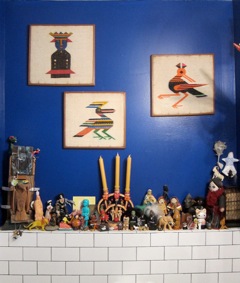
Multi-ethnic collection and random objects, basement bathroom. Photo courtesy of Edra Soto.
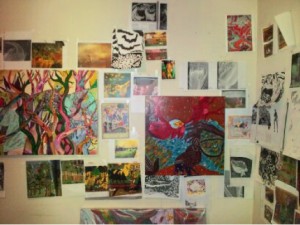 Image Machine. Photo courtesy of Carl Baratta.
Image Machine. Photo courtesy of Carl Baratta.
-Thea Liberty Nichols
Describing some rooms and areas of the RBSC by conventional room functions doesn’t always make sense. Such is the case with “the living room” and “the dining room,” identified as such due to the dining table in the former and the sofa in the latter, both of which are so covered with objects, that eating a meal or relaxing are no longer the point.
On the north wall in between what we might call the dining and living rooms hangs the curious painted object, Old Abe. It’s one of the oddest examples of paint on velvet that we’ve ever encountered; leave it to Roger to find the unusual example of whatever.
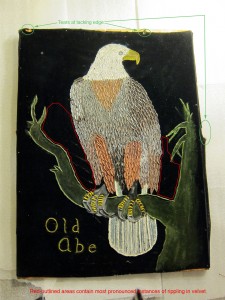
- Old Abe unframed with conditions noted by Tim Fox.
We call it a painting, but rather than being painted, per se, the image is constructed. The artist (as yet and most likely forever unidentified) created an eagle with talons gripping the branch upon which it’s perched, with carefully applied, thick, V-shaped globs of paint. The branch, tail, and title are edged in glitter, mixed with or applied on the textured paint. It’s installed near the ceiling so under normal circumstances it’s hard to get near enough to see the peculiar surface.
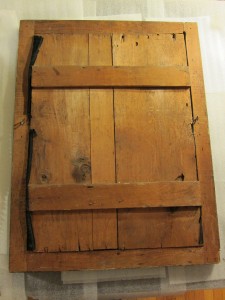
- Old Abe original wood backing
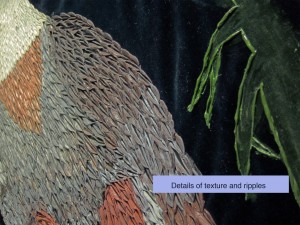
Here’s a bit about Old Abe, excerpted straight out of Wikipedia (http://en.wikipedia.org/wiki/Old_Abe):
Old Abe (c.1861 – March 28, 1881), a female bald eagle, was the mascot of the 8th Wisconsin Volunteer Infantry Regiment in the American Civil War and is the screaming eagle mascot depicted on the insignia of the U.S. Army’s 101st Airborne Division.
Old Abe was captured in 1861 by near the Chippewa River by Ahgamahwegezhig (Chief Big Sky) near the town of Jim Falls, in Chippewa County, Wisconsin. She was subsequently traded to local farmer, Daniel McCann, for a bushel of corn, who in turn sold her to the 8th Wisconsin’s Company C for $2.50.
Company C named the eagle after President Abraham Lincoln, and designed a special perch on which they carried the bird into battle. Old Abe participated in the Second Battle of Corinth (in which the 8th Wisconsin lost half of its men) and the Siege of Vicksburg, among other battles. In battle, Old Abe quickly became legendary, screaming and spreading her wings at the enemy. Confederate troops called her the “Yankee Buzzard” and made several attempts to capture her but never succeeded. Several times she lost feathers to bullets and saw her handlers get shot out from under her. When passing by, Generals Ulysses S. Grant, William T. Sherman, and William Rosecrans were known to doff their hats to the eagle.
The State Historical Society of Wisconsin’s website refers to Old Abe as a male bird, and notes:
At the end of the war Old Abe was presented to the State of Wisconsin. For fifteen years he lived in the “Eagle department” in the basement of the Capitol building, attracting thousands of visitors. During this period Old Abe also served as the star attraction of many fundraising events, earning politicians and charities thousands of dollars.
Old Abe’s long life ended March 26, 1881 when he died from smoke inhalation during a fire near his home in the Capitol. His remains were mounted and for the next 20 years his body remained on display in the rotunda of the Capitol building. After construction of the new State Historical Society building in 1901, Old Abe was briefly housed at that facility before being moved back to the Capitol in 1903 by order of Governor LaFollette. Sadly, Old Abe’s remains were destroyed when the Capitol building burned down on February 26, 1904.
Our grand bird-on-velvet had seen better days as well. The velvet, mounted directly on a rough wood backing, was slumping in its mount, and the paint was pressed against the glass. In early January, objects technician Tim Fox took the painting out of the frame, cleaned the velvet and paint, reinforced the fabric’s edges and mounted it on a new support composed of acid-free 4-ply museum board laminated to a thin panel of high-quality sealed plywood. Tim added a spacer between the painting and the glass, using wood he salvaged from WPA mural stretchers from Lane Tech High School.
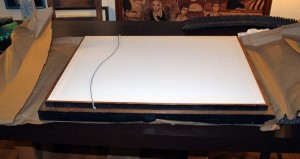
- New backing for Old Abe
These steps returning it to a much closer approximation of its original appearance, while also minimizing the inherent affects/speed of ageing going forward. Conserved and re-housed, Old Abe is refreshed and enigmatic as ever.
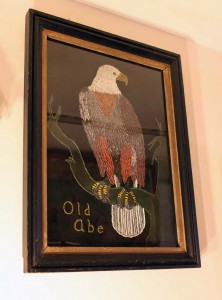
- Old Abe restored and reinstalled
-Lisa Stone
Posted in ALL THE NEWS on Monday, December 19th, 2011
Just Add Water….
In July heavy rain flooded the basement at 1926. Among the hidden treasures we exhumed during the cleanup were eight carved and silver-painted panels of draped fabric with billowing folds. In a 1995 video they appear installed in Brown’s studio and he explains that these lovely, enigmatic objects were panels from a hearse, found at a yard sale outside of Chicago. They may have been from a horse drawn hearse or a horseless carriage–we’re still researching the history of these wonderful examples of the persistence of the Victorian mourning tradition past Victorian times. They’re on view in our display entitled Drapery & Death. Opposite the panels, we hung Brown’s somber study of Daedalus and Icarus flying against a luminous, billowing cloudscape.
We spend much time considering the objects in Brown’s collection and it was exciting to discover the objects he chose to hang in his studio. The panels, muses perhaps, reflect Brown’s aesthetic sensibility, recalling the theatre drapery from his early works, the many slides of draped fabric from his travels, and the signature clouds that form the visual and conceptual backdrop for so many paintings.

James Connolly and hearse panels
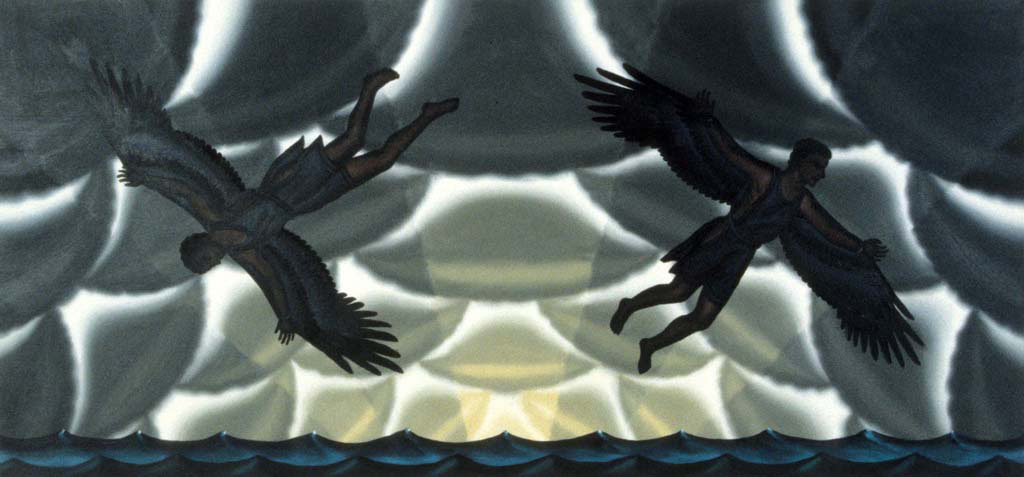
Roger Brown, Untitled (Study for Daedalus and Icarus mural), 1989, oil on canvas,25 1/2 x 54 in.
Classes, guests
Fall semester was packed with 60 SAIC classes and many other guests, with over 2200 visitors this year, a major uptick from 2010. Exciting uses of the collection included:
Mark Jeffery’s Performing the Document class addressing the building and collections as one grand archival document, evidence of a creative life lived, thought, and responded to. They explored the site and created and performed works in the basement, throughout the collection, in the gallery, bathroom, garage, and out in the alley, bringing the site and it’s histories to life in fresh, imaginative, and deeply thoughtful ways.
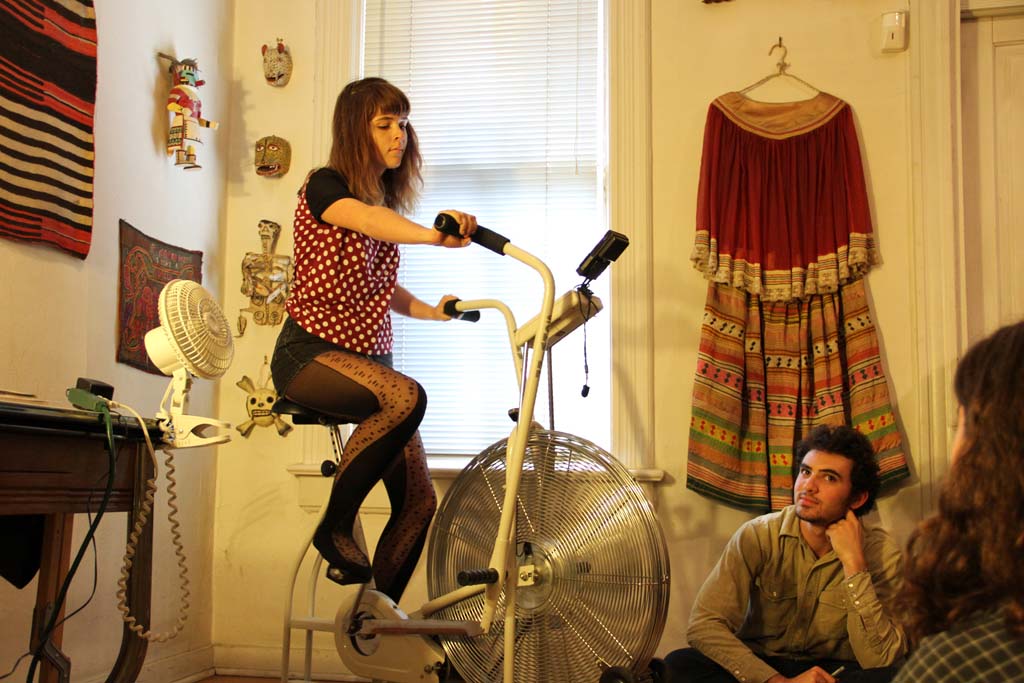
Peter Exley treated his Research Studio class to an evening with
Jon Langford, artist and musician (the Mekons, the Waco Brothers), who talked about his early years as an art student, showed slides of his paintings of classic country western musicians, and gave us a little concert.

Jon Lanford (not at 1926)
We hosted several departmental retreats, including Walter Massey’s President’s Cabinet, endearing many key administrators to 1926 as an inspiring place for administrative gatherings.
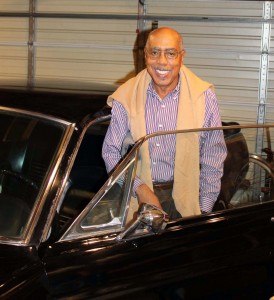
SAIC President Walter Massey posing with the Mustang.
Intuit hosted a bike tour of unusual sites around Chicago; approximately 50 intrepid cyclists parked their bikes in the ally, gathered in the garden and downed gallons of apple cider and (in smaller groups) toured the collection.
Preserving 1926
The summer flood was a calamity turned blessing in disguise. A crew completely emptied, cleaned, and sanitized the basement and repaired the stairway. We discarded a small mountain of detritus that accumulated over the years, possibly since the century before last. The basement was transformed from a dismal crypt into a clean space with epoxy-painted floor, new wire shelving, and expanded storage and workspace, all elevated high enough to weather any future storms. The project took several weeks, knocking other projects to the back burner, and instigated the reorganization of many materials and collections.
In August we received architect Tom Bassett-Dilley’s Code and Occupancy Study, commissioned last spring. The study outlines necessary modifications to the building organized into two phases. Instructional Resources and Facilities Management (IRFM) retained Bassett-Dilley (assisted by Von Dreele-Freerksen Construction Co.) to do a scope-of-work outline for all the recommendations. Working with IRFM staff, the facilities renewal was updated to 2017 and includes maintenance and upgrades to many elements and systems.
The door to the north stairway is being restored by Neal Vogel/Restoric to its 1995 appearance–largely the original 1888 design. The door will be much stronger, weather-tight, and more impervious to the elements. We recently found this photo of Roger’s parents at the north door, giving us much needed archival documentation for the finish.
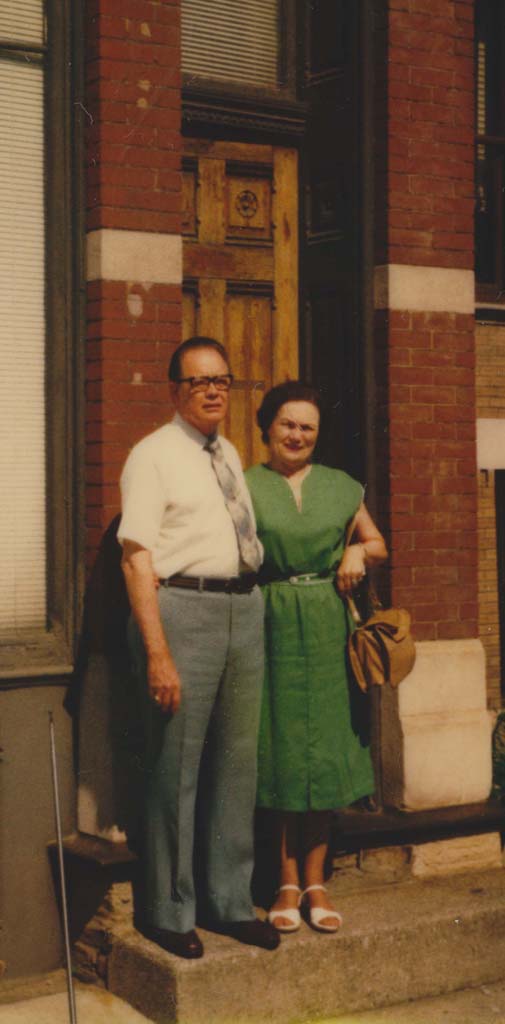
Mr. and Mrs. Brown at 1926, c. 1975
Restoric prepared and coated the cast iron entry porch and threshold, a seemingly minor but significant improvement. The cast iron was corroding badly, as the porch tilts downward allowing rain water and snow to collect and dwell.
The storefront entry doors are perhaps the most used and abused elements of the building. These drafty doors have deteriorated over the years. Just in time for the winter solstice, Restoric removed the doors to undertake a complete restoration. This major project is funded by a generous grant from the Walter and Karla Goldschmidt Foundation.

WATCH THIS SPACE!
Archive, collections
The flood set a number of organizational projects into motion. The contents from Brown’s kitchen cabinets had been stored in the basement for years. We unpacked, cleaned, and photographed, and carefully documented 169 objects, honing our abilities to describe housewares along the way, before repatriating the objects to their rightful place in the kitchen.
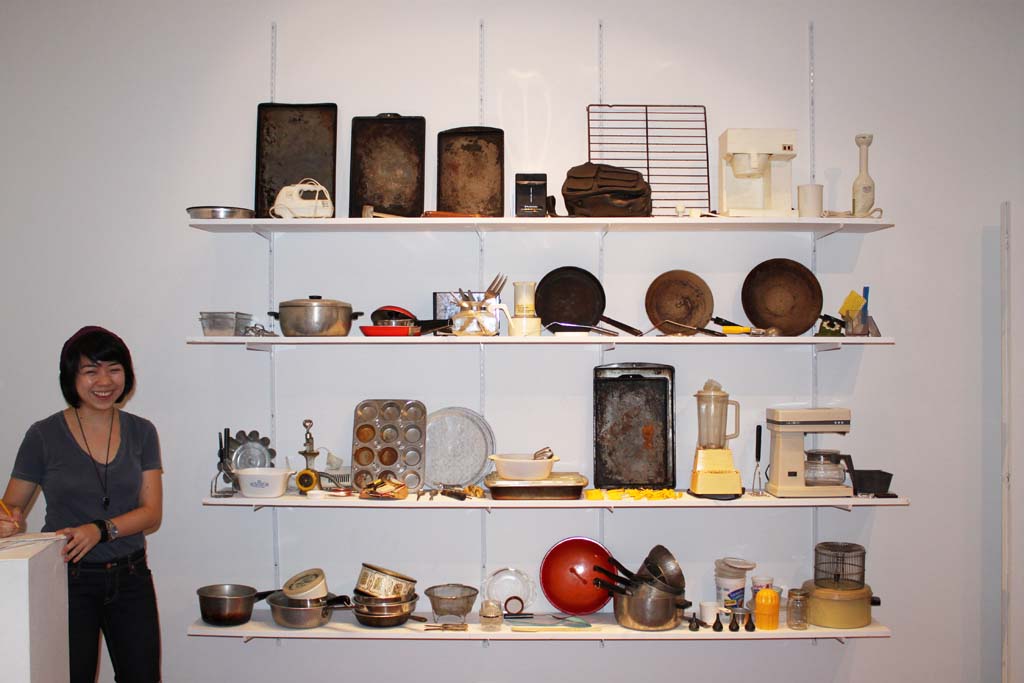
Ariel Fang and kitchen objects
Adventures in archiving…
Leslie Buchbinder, director of Pentimenti Productions, continues work with her team on research and production of a major documentary video on Chicago Imagist art. We’re providing Pentimenti Productions in-depth access to the RBSC Archive to support this wonderfully stimulating and mutually beneficial project. Leslie added James to the Pentimenti team, and in this role he’s scanning scads of images and documents, including a large measure from the RBSC archive, according to preservation standards. Pentimenti generously covered the cost of transferring Roger’s Super-8 home movies to dvd, among other contributions to the RBSC archive. This and the ongoing scanning project continues to advance the organization of our archive and our understanding of our holdings, greatly. Working with the Pentimenti team continues to be a true adventure in mining archival materials for the golden nuggets they contain. Watch this space for more information on Pentimenti’s forthcoming video production.
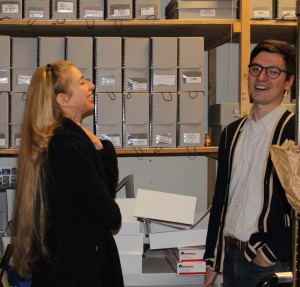
Leslie Buchbinder and Brian Ashby hard at work.
La Conchita collection
La Conchita collection curator Nick Lowe is spending his year-long sabbatical delving deeply into Roger Brown’s homes, gardens, collections, and artworks, both real and imagined. Over the summer he worked on the La Conchita inventory, updating and refining the database with works not examined or used in the Calif. U.S.A project. In September Nick and assistant curator James Connolly travelled to the Roger Brown Rock House Museum (Beulah, Alabama), where they scanned many archival materials, including photos, letters, writings, and ephemera. He then spent two weeks in Roger’s Spartan trailer at the Museum of Jurassic Technology, fine tuning the documentation of the La Conchita garden, planning a partial re-creation of the garden around the trailer, and creating a scale model of the trailer, adding to his ongoing creation of scale models of the La Conchita home and garden. Nick spent two weeks in October at the New Buffalo site, where he began constructing a scale model of Roger’s architectural drawings for an unrealized adobe house and compound in Lompoc, CA. Nick’s intensely focused research lends ongoing, high-level inspiration to our work at the RBSC and New Buffalo. Please peruse Nick’s project blog for more information about this incredible, ongoing project.
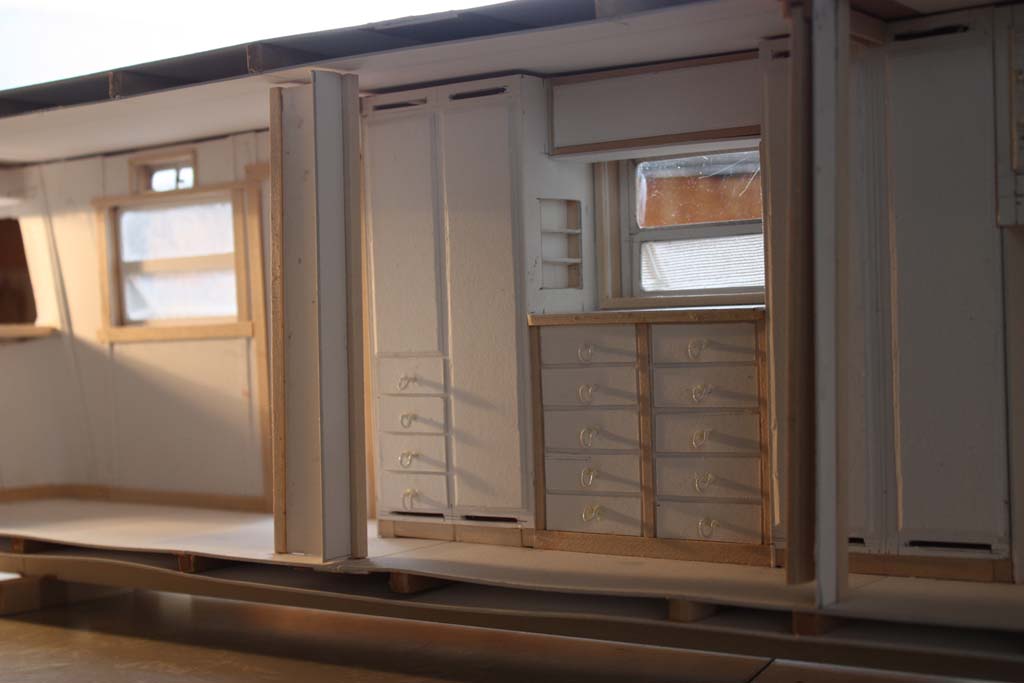
Detail, Nick Lowe's model of the Spartan trailer
Volunteers
Enthusiastic thanks to Justin Bergquist, Dana Boutin, Laura Fox, Leland Meiners, Thea Nichols, Dahlia Tullett, Bob Wimp, and Jamie Young for assisting with public tours and receptions. We’re sorry to have lost Laura Fox as an RBSC volunteer but we wish her the very best at her new job as public relations manager for three state museums in Doha.
Roger Brown / New Buffalo, Michigan site
This spring ongoing maintenance of the New Buffalo site addressed sanding and refinishing the floors and repairing and painting the walls in the River Pavilion. In mid May, James, Nick, and I worked with Tim Fox and his crew to de-install the entire collection of art and furniture and move it to the Studio and Guest House. In the process we cleaned and photographed each object and created new inventory records. In early June we reinstalled the collection in the newly refurbished house. We created a detailed de-installation/re-installation manual for future projects. A new security system was installed and the dining room chairs were reupholstered. (See the previous blog post for more on this project.) Working with Historic Preservation program faculty member Carol Yetken, CYLA, we’re moving forward on the restoration of the historic landscape at the New Buffalo site in spring 2012.
Brown / Palmer family
We join the Brown family in mourning the passing of Aunt Iva Gamel, Roger and Greg’s (and our) beloved aunt. Iva’s daughter Trudy established a memorial in Iva’s name, benefiting the Roger Brown Study Collection. We look forward to celebrating Iva’s life and remembering her here at the RBSC.
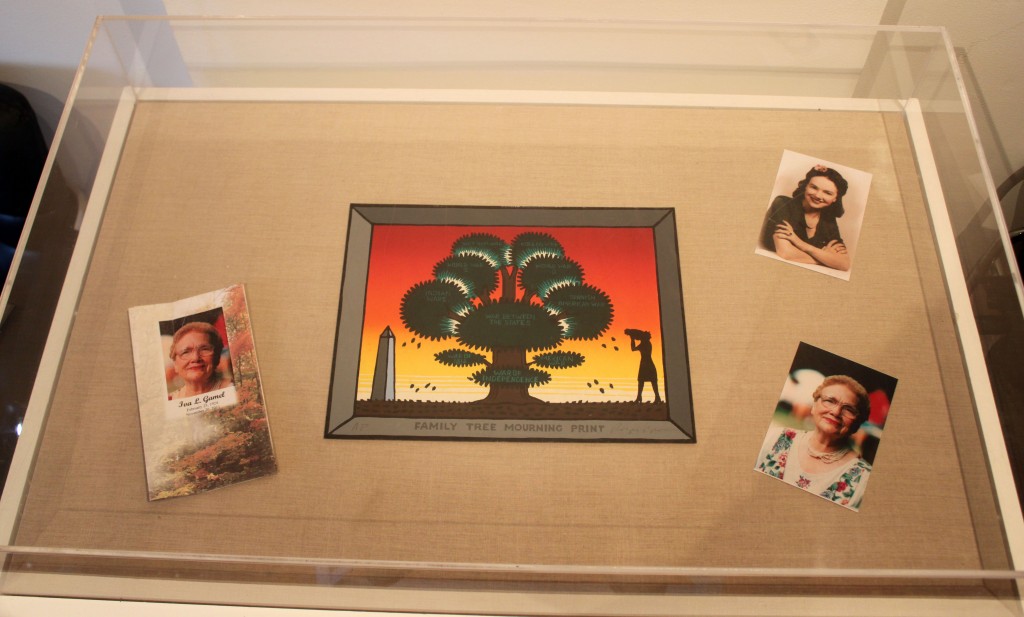
Vitrine for Aunt Iva
Roger Brown Estate
Russell Bowman, Russell Bowman Art Advisory, continues his representation of the Roger Brown Estate for SAIC, placing works in private and public collections and arranging exhibitions. Bowman placed Brown’s iconic painting, Dr. Imperial’s Tree of Knowledge (1985, oil on canvas, neon, 106 x 73 x 3 1/2”), which had hung in Brown’s La Conchita, California home, in the collection of the Montgomery Museum of Fine Art. Bowman is working with DC Moore Gallery in New York and Zolla Lieberman Gallery in Chicago on exhibitions of Brown’s work in 2012 and 2013. Zolla Lieberman Gallery included works by Brown in their booth at Art Miami in December.
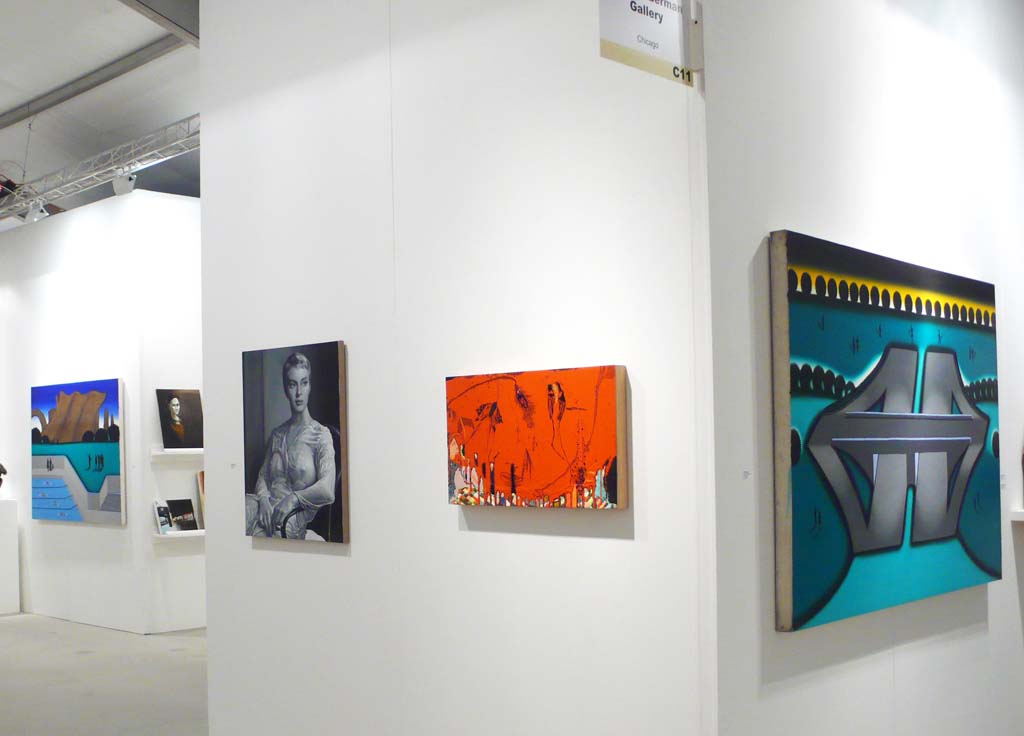
Brown works in Zolla Lieberman booth at Art Miami
This past summer I assisted RBSC staff members Lisa Stone and Nick Lowe along with art conservator Tim Fox and his team of art handlers, Kelly Stachura and Daniel Baird, in deinstalling and then reinstalling Roger Brown’s collection at his New Buffalo, Michigan residency for the interior to be worked on.
The entire process, partially documented in the video below, consisted of gathering meticulous measurements of all of Roger Brown’s hanging hardware as well as extensive photography of every area of the collection to ensure the reinstallation was exactly how Brown intended it to be. Every object was then cleaned, photographed, measured, and conditioned before being reinstalled based on diagrams we created from photographs and measurements.
http://www.youtube.com/watch?v=4-nDYfLyh7g
Video by James Connolly
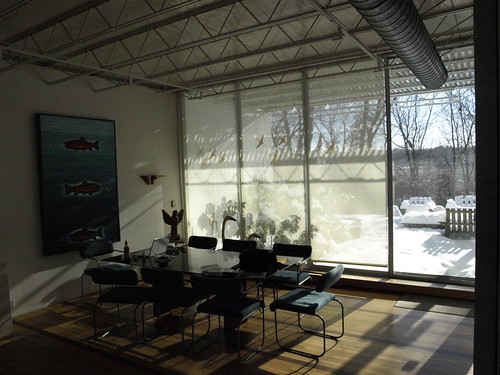
Gifted to the School of the Art Institute of Chicago in 1995 to be used as an artist’s retreat, Roger Brown’s former home, studio, and collection in New Buffalo, Michigan is an incredible architectural space. Designed by Brown’s partner, the architect George Veronda, the building channels Mies van der Rohe’s Farnsworth House in its openness to the natural world surrounding it, in this case the Lake Michigan sand dunes. The collection contains work by several Chicago artists including Ray Yoshida, Ed Paschke, Jim Nutt, Sarah Canright, Karl Wirsum, and Robert Gordy among several others, and the setting influenced numerous important paintings made by Roger Brown in the 1980s and 90s. More information can be found here.
-James Connolly
Posted in ALL THE NEWS on Wednesday, November 23rd, 2011
Roger Brown,
December 10, 1941 – November 22, 1997
Roger Brown’s magnanimous gifts continue to enrich SAIC in uncountable ways, and there are always new discoveries. We recently unpacked (from storage) eight carved and silver-painted panels of draped fabric with billowing folds. In a 1995 video we see them installed them in Roger’s studio and he explains that these lovely, enigmatic objects were panels from a hearse, found at a yard sale outside of Chicago. It was an epiphany of sorts, to find out what he chose to live with in his studio. The panels, muses perhaps, relate seamlessly to Roger’s’s aesthetic sensibility, recalling the theatre drapery from his early works, and the signature clouds that form the visual and conceptual backdrop for many paintings. Thank you Roger Brown.
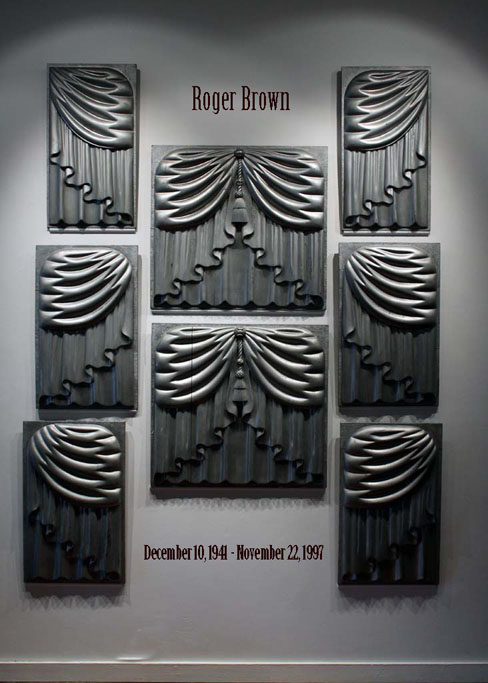
Iva Louise Gamel
February 24, 1924 – November 20, 2011
Roger’s Aunt Iva was our adopted aunt and beloved friend of the RBSC. From the time Roger moved to Chicago in the early 1960s, Iva faithfully attended every single of Roger’s openings in the Chicago area, and she continued to travel to many RBSC events. She would always cheerfully talk with students, share memories, and otherwise function as a living archive.
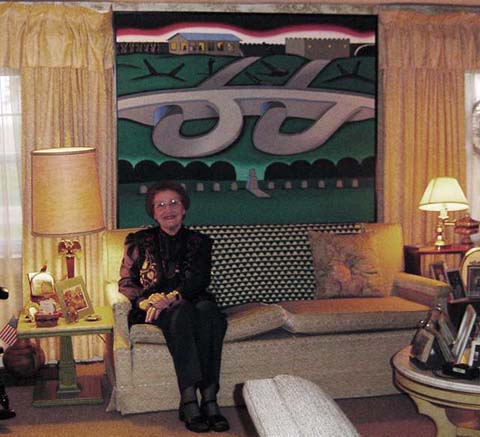
Aunt Iva’s obituary can be read here
-Lisa Stone
Posted in Uncategorized on Saturday, April 30th, 2011
The Roger Brown Study Collection community sends out our condolences to the families and individuals directly affected by the devastating tornadoes that hit the Southern states on Thursday, April 27, 2011. We were especially troubled to hear about the catastrophe and casualties in Alabama, Roger Brown’s home state. Our hearts go out to those who have suffered personal loss due to the tornadoes. No matter where they are in the world we will be thinking of you.
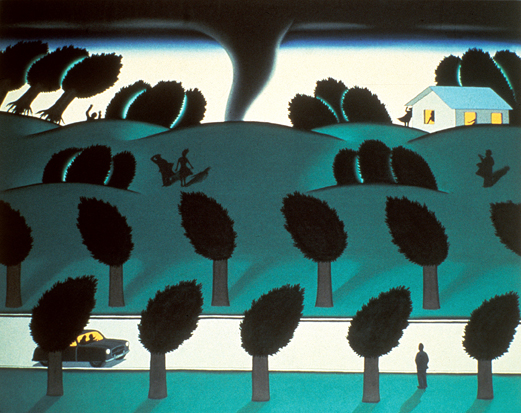
Twister, 1972, 48 3/8 x 60 ½
During such a difficult time we look to Roger Brown and his works to help us sort through and meditate on what has happened. Roger loved Alabama intensely- his passion for the community and land could be seen in his works and collections throughout his life. However Roger also understood the awe striking power and terror that nature can conjure. His painting Twister (1972, 48 3/8 x 60 1/2) depicts this understanding and respect for nature. In the painting one can see the tornado on the verge of tearing across the land. Almost all the people in the picture are frozen in fright. However one solitary man stands in the bottom right corner pensively gazing at the oncoming force.
Roger ‘s message is an important and extremely relevant one:
We are torn by what has happened in Alabama and the other Southern states. But it is important to realize that it is during these moments that humanity genuinely and selflessly comes together. Together the world can heal the scars left by any disaster.
-Ariel Fang
Heather Reed recently brought her class of first-graders to the RBSC for a unique museum experience on all ends.
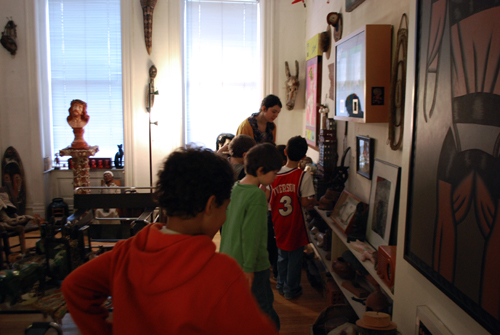
Laura Bickford guides a group of students through the living room of the Study Collection
The students, who have been studying the work of Roger Brown, impressed all of us at the RBSC with their ability to recognize Brown’s artistic style by pointing out his silhouetted figures and stylistic compositions and colors. It was great to have the enthusiastic group bring their unique perspectives as we discussed the work of Joseph Yoakum, Aldo Piacenza, Karl Wirsum, and other artists in the collection and we hope they visit again!
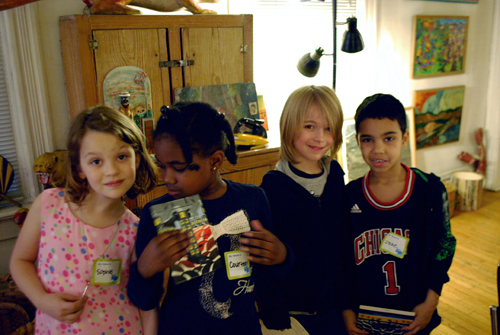
Students pose for a photo showing off their Roger Brown note cards
RBSC volunteer and SAIC staff member Thea Liberty Nichols recently interviewed several friends of the RBSC as a guest blogger for the Bad at Sports blog in a series of posts focusing on contemporary arts writing.

Featured were discussions with RBSC volunteer Laura Fox, SAIC grad student and writer of the successful nomination for 1926 N. Halsted Street to be listed on the National Register of Historic Places Susannah Ribstein, and RBSC assistant curator James Connolly.
Posted in STAFF PICS on Wednesday, March 16th, 2011
I’ve often started tours of the RBSC by gathering a group around the Barcelona table in the living room, using it to introduce the logic behind the formation of Roger Brown’s collection.
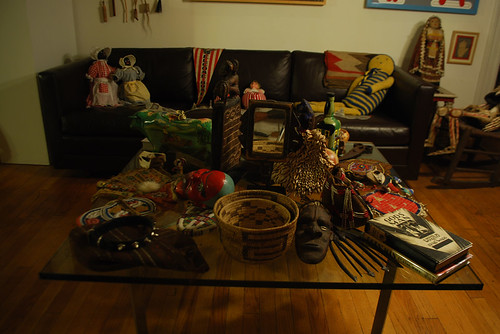
Located centrally in the living room of Roger Brown’s former Chicago home, the Barcelona Table and the objects on it reveal the convergence of Brown’s taste with that of his partner, the architect George Veronda. The pinnacle of modern architecture and design, the work of Mies van der Rohe exemplifies simplicity of structure and form, yet finds new life in the obliteration of its spareness by Brown’s installation of transcultural art and everyday objects. What is supposed to be an object of minimal design becomes one art-object among many, a well-designed display for a painted Jack Daniels bottle, a spiked dog collar, African sculptures, a novel in woodcuts by Lynn Ward, among many other things. The lack of hierarchical relationships between objects and the juxtaposition of seemingly incompatible origins relates to Brown’s methodology of collection and arranging, inviting the viewer to form their own themes and correlations through their own interpretations.

With the help of RBSC interns Courtney Bird Ziegler and Danny Augustine I recently deinstalled, cleaned, and reinstalled Roger Brown’s arrangement of objects on the Mies van der Rhoe Barcelona table. Documenting the reinstallation process, we created a series of photographs showing the display in various stages, revealing the process behind Brown’s installation.
The complete set of photographs can be found on our flickr set here.
In the end, the table reveals Roger Brown’s collection to have been developed within the culture of inclusion that has existed within and around the School of the Art Institute of Chicago from Helen Gardner to Whitney Halsted and Ray Yoshida and beyond. Gardner, who started teaching at SAIC in 1920, wrote Art Through the Ages, the first art history textbook to include both Western and Eastern cultures. Whitney Halsted, an art history instructor at SAIC while Brown was a student encouraged his students to explore the galleries of the Field Museum of natural history to be exposed to art from non-Western cultures, while Ray Yoshida, Brown’s painting instructor, pushed students to visit places like the Maxwell Street Market in search of various found objects.
Roger Brown continued and expanded upon these traditions in his own collecting practices, combining cross-cultural artworks and various other objects with works by artists contemporary to him such as Henry Darger, Jesse Howard, Jim Nutt, Aldo Piacenza, Barbara Rossi, Drossos Skyllas, Joseph Yoakum, and Karl Wirsum (among many, many others) in ways that lacked museum-like separations into various categories. Talking about his own methods of collecting and displaying objects in a letter to RBSC curator, Brown referenced the table directly as being emblematic of his curatorial point of view:
I think keeping masses of objects on the Barcelona Table is something that expresses my attitude toward art. Both the table and every little thing on it is aesthetic if not art on its own right. I like breaking the Meisian simplicity of the “horror vacui”⎯though I fully appreciate both very valid attitudes in art.
-James Connolly
« Older Entries Newer Entries »






























